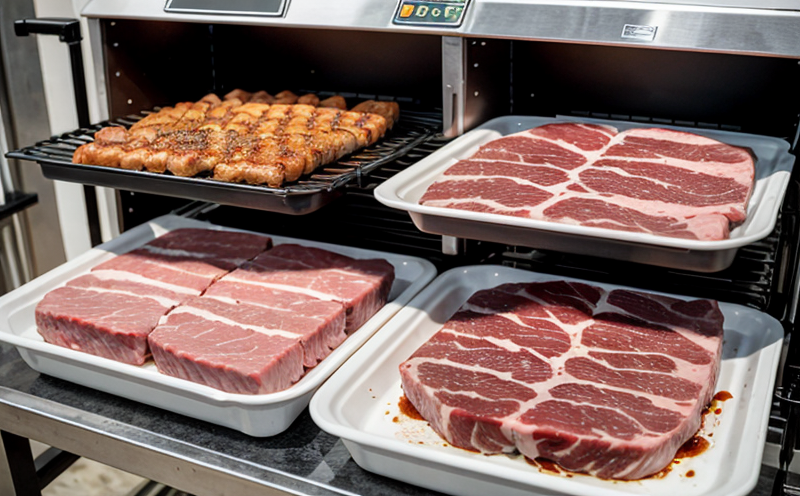ISO 937 Protein Content Testing in Meat and Poultry
The ISO 937 standard provides a precise method for determining protein content in meat and poultry products. This test is crucial as it ensures product quality, compliance with international standards, and consumer trust. In the food and feed sector, where traceability and safety are paramount, accurate protein content testing is essential to avoid recalls and maintain brand reputation.
ISO 937 specifies a gravimetric method using sulfuric acid digestion followed by titration with sodium hydroxide solution. This method is particularly effective for meat and poultry products due to their complex composition of proteins, fats, carbohydrates, and other components. The test parameters include the precise preparation of samples, digestion in sulfuric acid, distillation, absorption into a sodium hydroxide solution, and subsequent titration.
The acceptance criteria are based on the gravimetric results obtained from the titration process. Variations in protein content can lead to discrepancies in labeling and nutritional information provided to consumers. Compliance with this standard ensures that products meet the expected quality benchmarks set by regulatory bodies like the FDA or EU Commission.
For instance, a meat product labeled as containing 20% protein must have an actual protein content within specified limits defined by ISO 937. This tolerance range is critical for maintaining consistency across different batches and ensuring that consumers receive products that meet their dietary expectations.
The importance of this testing cannot be overstated, especially in the context of food safety and quality assurance. Inaccuracies or inconsistencies can have severe consequences, from legal ramifications to reputational damage. By adhering to ISO 937, laboratories ensure they are contributing to a safer and more reliable supply chain.
Moreover, this testing method is not just about compliance; it’s about enhancing product value by ensuring that the nutritional content of meat and poultry products aligns with consumer expectations. This is particularly relevant in markets where transparency and authenticity are highly valued. In an era where food fraud and adulteration are increasingly prevalent issues, ISO 937 stands as a beacon of integrity.
Understanding the nuances of this testing method helps quality managers and compliance officers make informed decisions that impact both the business operations and customer satisfaction. By leveraging advanced analytical equipment such as spectrophotometers or pH meters, laboratories can achieve accurate results that are repeatable and reliable.
Why It Matters
The accuracy of protein content testing in meat and poultry is critical for several reasons:
To ensure product labeling is truthful and compliant with regulations.
To maintain consumer trust by delivering products that meet expected nutritional profiles.
To prevent food adulteration, which can compromise product quality and safety.
To support traceability in the supply chain, ensuring that all stakeholders have confidence in the integrity of the products they handle.
Protein content testing is not just a technical exercise; it is a cornerstone of food safety and quality assurance. It plays a vital role in maintaining consumer trust and regulatory compliance. By adhering to ISO 937, laboratories contribute significantly to ensuring that the products they test are safe, reliable, and meet the highest standards.
Benefits
The benefits of implementing ISO 937 protein content testing in meat and poultry include:
Enhanced product quality and consistency.
Compliance with international standards, which is essential for export markets.
Increased consumer confidence through accurate nutritional labeling.
Reduction in the risk of food fraud and adulteration.
Improved traceability within the supply chain, aiding in quick response to issues.
These benefits extend beyond mere compliance; they contribute to building a resilient and sustainable industry. By adhering to these standards, laboratories play a pivotal role in ensuring that meat and poultry products are not only safe but also of high quality.
Quality and Reliability Assurance
Consistent sample preparation ensures accurate digestion and titration results.
Precision in the use of reagents like sulfuric acid and sodium hydroxide is critical for reliable outcomes.
Regular calibration of analytical equipment guarantees that all measurements are accurate and consistent.
Adherence to ISO 937 ensures that results are repeatable, which builds trust within the industry.
Quality assurance in protein content testing involves not only the accuracy of the test but also the integrity of the sample preparation process. By following strict protocols and using high-quality reagents, laboratories can ensure that their findings are reliable and reproducible. This commitment to quality is reflected in the consistent results achieved across different batches and samples.
The reliability of ISO 937 testing is further enhanced by the use of advanced analytical equipment such as spectrophotometers or pH meters. These instruments provide precise measurements, which are essential for accurate protein content determination. Regular calibration ensures that these tools remain in optimal working condition, thereby maintaining consistent and reliable results.
By adhering to ISO 937, laboratories ensure that they are contributing to a safer and more reliable supply chain. This not only protects consumers but also strengthens the industry’s reputation for integrity and excellence. The commitment to quality and reliability is a cornerstone of successful food and feed testing operations.





